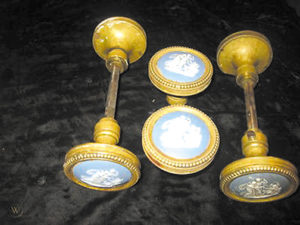 By Anne Gilbert
By Anne Gilbert Did you ever think of old hardware as decorative art? Surprisingly there are many serious collectors who proudly display antique and vintage brass and iron doorknobs, locks and other examples. They also buy reproductions. There was a time when these artifacts could be found in salvage lots and flea markets. But, they became trendy by the 1970s. Buyers of period homes often need to replace door knobs and other old pieces.
Keep in mind that current design trends over the centuries also appeared on hardware. Eastlake, Arts and Crafts and Mid-century Modern, to mention a few.
Historically, the look and mechanical techniques of hardware have undergone many changes over the centuries. They have come a long way from the simple locks and keys made in Egypt 4,000 years ago. In ancient Rome the keys had become iron and bronze. It was there that the first use of “wards”(fixed projections’ in a lock) to ward off entry. Padlocks also had early beginnings in many ancient cultures including China. They were made of bronze and brass. Credit the ancient Greeks with inventing the keyhole.
By Medieval times French and German locksmiths trimmed their lock plates with Gothic moldings and carvings. Among the most important makers of hardware was Enoch Robinson (1801-1888). Many of his locks and escutcheons were bronze. They are still in use in old Boston hotels and on doors in the United States Treasury building.
 During the 19th century some beautiful Wedgwood doorknobs were made. Periodically they turn up in shops and auctions. Some fascinating reproductions are available on the internet.
During the 19th century some beautiful Wedgwood doorknobs were made. Periodically they turn up in shops and auctions. Some fascinating reproductions are available on the internet. If you are more concerned with the beauty of design than historical purpose there are reproductions of elaborate workmanship of the Ming and Qing Dynasties.
Sometimes an old trunk or valise that is falling apart has hardware worth saving. One type was made by the Eagle Lock Company in the late 19th century. It was a brass crop with an eagle motif. Other examples were japanned.
CLUES: If you are thinking about beginning a collection take a trip to the “Lock Museum of America in Terryville, CT. It is a visual tour of lock history beginning with examples from ancient Egypt to 20th century America.
Once you are serious about collecting contact The Antique Doorknob Collectors of America. They have a monthly newsletter and yearly convention. information on the internet. Check out eBay for unrecognized treasures.
PHOTO CAPTIONS (1) Wedgwood Jasperware door knob. 19th century. PHOTO CREDIT: eBay (2) Qing lock. 18th century. PHOTO CREDIT: eBay















Follow Us